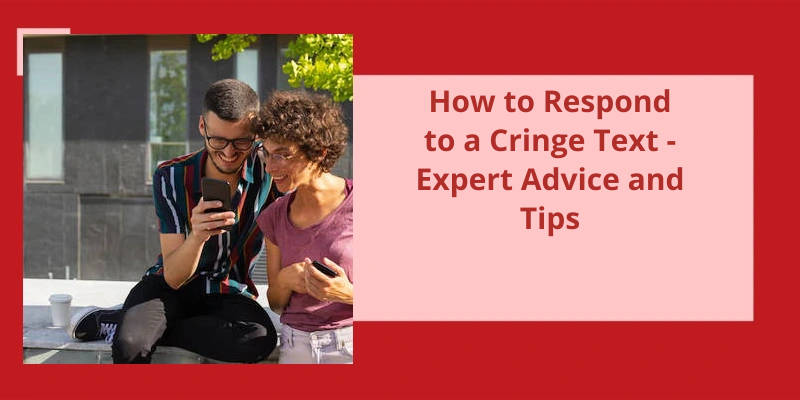Have you ever received a cringe-worthy text that left you at a loss for words? Whether it's an awkward confession, a bizarre request, or a cringey screenshot, knowing how to respond to a cringe text can be a challenge. Fortunately, we’re here to provide you with expert advice and tips on how to handle these uncomfortable situations with grace and tact. From laughing off the situation to asking for clarification, empathizing with the sender to changing the topic, we’ve gathered 11 effective responses for any cringe text scenario. So, the next time you find yourself face-to-face with an uncomfortable text, you'll know exactly how to reply and navigate the situation smoothly.
How Do You Get Over Cringe Texts?
Every now and then, we find ourselves sending a text message that instantly makes us cringe. Whether it’s a typo-ridden message to the wrong person or an embarrassing confession made in a moment of weakness, these cringe-inducing texts can leave us feeling mortified. So, how can we get over these cringe-worthy moments?
One way to begin the process of moving on from a cringe text is to acknowledge it. Instead of pretending like it never happened, confront the situation head-on. This could involve sending a follow-up message, apologizing for any misunderstandings or unintended consequences caused by your text. Taking responsibility for your actions can help you regain some control over the situation and potentially salvage the relationship.
Another strategy to overcome the embarrassment of a cringe text is to own it. Embrace the fact that you made a mistake and accept that everyone is prone to these moments of awkwardness. Share your experience with a trusted friend or confidant, and let them remind you that we all have our fair share of blunders. By acknowledging your mistake and accepting it as a part of your journey, you can start to release the shame and embarrassment tied to that text.
Humor can be a powerful tool in diffusing uncomfortable situations, including those caused by embarrassing messages. Find the humor in your mishap and share a laugh with friends or even the recipient of the text. Allowing yourself to find the funny side of the situation can help you release any residual embarrassment and move on with more ease.
Lastly, it’s essential to learn from your mistakes. Take the lessons gained from sending that cringe-worthy text and apply them to future interactions. Use the experience as an opportunity for personal growth and reflection. By identifying what went wrong and how you can avoid similar situations in the future, you empower yourself to make better choices and communicate more effectively.
When faced with annoying texts, it can be tempting to respond with a cutting remark or engage in an argument. However, a more effective approach is to shut them down with a brief response and wait until they’ve calmed down. Phrases like “You didn’t have to say that,” “You’re being immature,” or “Don’t be mean for the sake of being mean” can help address the issue without escalating the situation. Alternatively, stating that you don’t wish to partake in an argument, or that you won’t entertain their behavior, can also establish boundaries while maintaining your composure.
How Do You Respond to Annoying Texts?
When faced with annoying texts, it’s important to respond in a constructive and mature manner. One effective approach is to shut down the conversation with a concise and firm response. This can be achieved by simply stating, “You didnt have to say that.”. By highlighting the unnecessary nature of their message, you’re subtly reminding them to reconsider their words.
Another approach is to address their behavior directly. By asserting, “Youre being immature,” you’re calling out their actions without stooping to their level. This response may prompt them to reflect on their behavior and potentially adjust their approach.
It’s essential to discourage mean-spiritedness without engaging in further conflict. In response to a cringe-worthy text, calmly state, “Dont be mean for the sake of being mean.”. This communicates your disapproval and encourages them to think before sending hurtful messages in the future.
Maintaining peace is crucial, especially when confronted with irritating texts. By stating, “I don’t want to get into an argument with you, so I won’t say anything,” you’re choosing to prioritize your own emotional well-being and disengage from a potentially volatile conversation. This response not only avoids unnecessary conflict but also demonstrates your maturity and self-control.
Sometimes it’s best to simply refuse to engage with cringe-worthy texts. By saying, “Im not going to entertain this,” you’re making it clear that you’ve no interest in prolonging the conversation or engaging in their negativity. This response sets a boundary and asserts your refusal to participate in any further unpleasant exchanges, deterring them from continuing their inappropriate behavior.
Remember, when faced with annoying texts, responding appropriately is essential. Choose your words wisely, prioritizing respect and maturity. By using brief and assertive responses, you can effectively shut down the conversation and discourage any further cringe-worthy texts.
Ignoring or Blocking the Sender’s Number
One way to respond to a cringe text is by simply ignoring it or blocking the sender’s number. This can be a useful strategy if the message makes you uncomfortable or if you don’t wish to engage with the sender. Ignoring the text allows you to avoid any further interaction or confrontation, while blocking the number ensures that you no longer receive messages from that specific sender.
We’ve all been there. You hit send, and immediately regret floods in as you realize the embarrassing text has been sent. In moments like these, it’s essential to find humor in the situation. Sending a self-deprecating joke like “Welp, didn’t mean to send that to you! Excuse me. Seeing myself out now,” can help diffuse the embarrassment and show that you can laugh it off.
What to Do if You Sent an Embarrassing Text?
What to do if you sent an embarrassing text? Laugh it off. Next to internal screaming, I think this is the most common method for recovering from an embarrassing message — make a joke of the whole thing! Send a quick “Welp, didn’t mean to send that to you! Excuse me. Seeing myself out now,” and leave it at that. Humor can often diffuse the awkwardness and show that you’re able to laugh at yourself. It can also lighten the mood and help both parties move on from the cringe-inducing moment.
Another approach is to acknowledge the situation head-on. Instead of ignoring the embarrassing text, take ownership of it and apologize if necessary. You can say something like, “Im so sorry for sending that text. It was not meant for you, and I feel really embarrassed about it. Please ignore it!”. By being upfront and sincere, you show that you’re aware of your mistake and genuinely remorseful. This can help rebuild any potential damage to the relationship.
If the recipient of your embarrassing text responds negatively or makes a big deal out of it, it’s important not to let their reaction consume you. Everyone makes mistakes, and while it may be uncomfortable, it’s a part of being human. Remember that you’re only responsible for your own actions, and their reaction is their own. Dont beat yourself up over it; instead, focus on moving forward and learning from the experience.
If the text was particularly cringe-worthy or had serious implications, talking it out and offering an apology in person can show that you’re genuinely sorry and willing to make amends. This can help create a more open and honest line of communication, allowing both parties to address any concerns and move past the awkward encounter.
Lastly, take this embarrassing moment as a lesson learned. Double-check your recipients, review your message before hitting send, and be mindful of what you share digitally. We all have our moments of embarrassment, but by being more cautious and thoughtful in our communications, we can minimize these cringe-worthy experiences. Learn from your mistakes and use them to become a better communicator in the future.
Tips for Preventing Embarrassing Texts in the First Place
To prevent sending embarrassing texts, it’s important to take a few precautions before hitting that send button. First and foremost, double-check the recipient to ensure you’re sending the message to the intended person. It’s also crucial to review your message for any potentially embarrassing or offensive content. Taking a moment to proofread can save you from potential cringe-worthy moments.
Another helpful tip is to avoid texting while under the influence of alcohol or other substances. Impaired judgment can lead to regrettable texts that you may end up cringing at later. Furthermore, consider the timing of your messages. Sending late-night texts when someone may be asleep or busy can lead to awkwardness.
If you’re unsure about the tone or content of your message, consider speaking in person or over a phone call instead of relying solely on texting. Non-verbal cues and tone of voice can help clarify any potential misunderstandings, reducing the chances of an uncomfortable exchange.
Lastly, it’s important to remember that everyone makes mistakes. If you do send an embarrassing text, take responsibility for it. Apologize sincerely and try to rectify the situation, but also learn from the experience to prevent similar situations in the future.
Source: How do I deal with sending an embarrassing text?..
Apologizing for a risky text can be a delicate task. When reflecting on the message, it becomes evident that it may have been misconstrued or misunderstood. Acknowledging this potential and expressing genuine remorse is key in the art of apologizing. Although it may seem endearing to express your anguish over the situation, it’s better to keep that sentiment to yourself. So, how can you navigate through this situation gracefully?
How Do You Apologize for a Risky Text?
When it comes to responding to a cringe-worthy text, offering a genuine apology is often the best approach. Reflect on the situation and acknowledge that your message may have been misinterpreted or offensive. For example, you could say, “Upon reflection, I now understand how that text message could have been perceived differently. I apologize if it came across as insensitive.”
Taking responsibility for your words shows maturity and helps to ease any tension that may have arisen from the situation. Avoid making excuses or deflecting the blame onto others. Instead, focus on expressing your genuine remorse for any unintended offense caused.
It can also be helpful to provide a brief explanation of the intention behind your text, particularly if it was meant to be humorous or lighthearted. This can help the recipient understand that your message was not intended to cause harm. For instance, you could explain, “I was attempting to make a joke, but I now realize that it may not have landed well. Im truly sorry if it came across as hurtful.”
If appropriate, you can express your willingness to discuss the matter further or clarify any misunderstandings that may have occurred. This shows that you value open communication and are committed to resolving any lingering concerns. However, be mindful of the recipients feelings and boundaries, as they may not be ready or interested in continuing the conversation.
Approach the situation with empathy and understanding, demonstrating that you’ve learned from your mistake and are committed to better communication moving forward.
Tips for Apologizing in Person After Sending a Risky Text
If you find yourself in the awkward situation of having sent a risky or cringe-worthy text, don’t panic. It happens to the best of us. Here are some expert tips on how to respond and apologize in person to minimize the cringe factor:
1. Assess the situation: Take a moment to evaluate the severity of the text and the potential impact it may have had on the recipient. This will help you determine the level of apology required.
2. Own up to it: Instead of avoiding the issue, acknowledge your mistake and take responsibility for your actions. Admitting that you made a cringe-worthy mistake shows maturity and sincerity.
3. Be sincere: A genuine apology goes a long way. Express your remorse and use heartfelt language to convey your feelings. Avoid being defensive or making excuses, as this may invalidate your apology.
4. Choose the right time and place: Find an appropriate setting to apologize in person. Make sure both you and the recipient are comfortable and have enough time to discuss the matter without distractions.
5. Listen and validate their feelings: Allow the other person to share their emotions and reactions to the text. Actively listen and validate their feelings, showing empathy and understanding. This will help rebuild trust and open the lines of communication.
6. Learn from the experience: Reflect on the cringe-worthy text and use it as an opportunity for personal growth. Understand why it was inappropriate and make a conscious effort to avoid similar mistakes in the future.
Remember, everyone makes mistakes, and how you handle them speaks volumes about your character. By following these tips, you can navigate the aftermath of a cringe-worthy text with grace and integrity.
It’s no secret that receiving a text response that simply says “K” can be incredibly frustrating.
What Is the Most Annoying Text Response?
It can feel dismissive and uninterested, leaving the sender feeling insignificant. It lacks any emotion or effort, which can be frustrating for the recipient who took the time to craft a thoughtful message. Additionally, the brevity of the response can be perceived as a lack of respect for the conversation or the senders feelings.
Instead of responding with a one-letter text, it’s important to consider the other persons feelings and respond in a way that shows engagement and empathy. Take a moment to think about the content of the original message and respond with something that acknowledges their thoughts or questions.
Offering a more detailed response can help bridge the communication gap and maintain a healthy conversation. It shows that you value the other persons input and are invested in the exchange. Whether it’s asking follow-up questions, sharing your own perspective, or simply showing gratitude for their message, there are countless ways to provide a more meaningful response.
Remember, effective communication requires effort from both parties. By avoiding the “K” response and putting in the time to send a thoughtful message, you can foster better connections and avoid unnecessary cringe moments in your text conversations.
Additionally, using a specific ringtone can be a helpful tool to know when to ignore a text without appearing rude. By assigning a unique tone to certain contacts or notifications, you can discreetly prioritize your responses and choose to disregard messages without causing offense.
How Do You Ignore a Text Without Being Rude?
When it comes to ignoring a text without coming across as rude, there are a few strategies you can employ. One of the most effective tactics is to come up with a polite excuse for not responding. For instance, you can pretend that you lost your phone during the time they were texting you. This way, you can blame your lack of response on circumstances beyond your control, rather than intentionally ignoring them. This excuse allows you to maintain a level of civility while still avoiding a potentially uncomfortable or cringe-inducing conversation.
Another helpful tip is to utilize customized ringtones. By assigning a specific ringtone to the person whose text you want to ignore, you can quickly identify when they’re reaching out to you without even checking your phone. This way, you can choose to ignore the text message discreetly, rather than blatantly disregarding it in front of others. This tactic allows you to save face and avoid any awkward situations that may arise from rejecting their messages in plain view.
In addition to these strategies, it’s important to convey your disinterest or lack of availability in a respectful and subtle manner. This can be achieved by delaying your response or providing brief, neutral replies that don’t encourage further conversation. By doing so, you’re gently hinting that you aren’t interested in engaging in a lengthy dialogue without directly rejecting or offending the person.
However, it’s worth noting that while ignoring a text may provide a temporary reprieve, it’s essential to address the situation delicately and honestly if you wish to maintain a healthy relationship with the individual. Ignoring someone for extended periods or repeatedly may lead to misunderstandings or hurt feelings. Therefore, it’s crucial to find the right balance between protecting your boundaries and maintaining open and clear communication with others.
Conclusion
In conclusion, when it comes to responding to a cringe text, it's important to approach the situation with empathy, understanding, and tact. Instead of ignoring or dismissing the message, consider various response options such as laughing off the situation, seeking clarification, empathizing with the sender, expressing gratitude, changing the topic, or addressing your feelings directly. Additionally, if necessary, there are responses like politely rejecting, making an apology, or finding a way to redirect the conversation. By utilizing these expert tips, you can navigate through awkward texts while maintaining healthy communication and preserving relationships.






